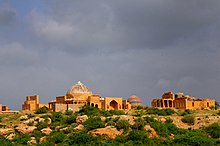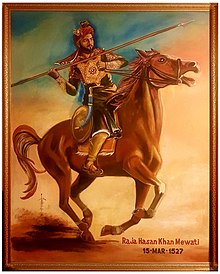Muslim Rajputs are the descendants of Rajputs of Northern regions of the Indian subcontinent who are followers of Islam. They converted from Hinduism to Islam during the medieval period in India, retaining their surnames such as Rana and Chauhan. Today, Muslim Rajputs can be found in present-day Northern India and eastern parts of Pakistan. They are further divided into different clans.
Contents
- History
- Conversion to Islam and ethos
- Medieval Muslim Rajput dynasties of the Indian subcontinent
- Soomra dynasty period
- Samma Dynasty period
- Kharagpur Raj
- Gujarat Sultanate
- Khanzada Dynasty
- Qaimkhanis of Fatehpur-Jhunjhunu
- Lalkhani Nawabs
- Mayi chiefs
- Notable people in medieval India
- Beliefs and customs
- See also
- References
History

Sumneus Khan of Ranghur Mahomedans(formerly Rajpoots) background from Hissar.
The term Rajput is traditionally applied to the original Suryavanshi, Chandravanshi and Agnivanshi clans, who claimed to be Kshatriya in the Hindu varna system.
Conversion to Islam and ethos
There are recorded instances of recent conversions of Rajputs to Islam in Western Uttar Pradesh, Khurja tahsil of Bulandshahr.
Upon their conversion from Hinduismto Islam, the Rajputs maintained many of their Hindu customs.
Despite the difference in faith, where the question has arisen of common Rajput honour, there have been instances where both Muslim and Hindu Rajputs have united together against threats from external ethnic groups.
Medieval Muslim Rajput dynasties of the Indian subcontinent
Soomra dynasty period
When Sindh was under the Arab Umayyad Caliphate, the Arab Habbari dynasty was in control. The Umayyads appointed Aziz al Habbari as the governor of Sindh. Habbaris ruled Sindh until Sultan Mahmud Ghaznavidefeated the Habbaris in 1024. Sultan Mahmud Ghaznavi viewed the Abbasid Caliphate to be the caliphs thus he removed the remaining influence of the Umayyad Caliphate in the region and Sindh fell to Abbasid control following the defeat of the Habbaris. The Abbasid Caliphate then appointed Al Khafif from Samarra; ‘Soomro’ means ‘of Samarra’ in Sindhi. The new governor of Sindh was to create a better, stronger and stable government. Once he became the governor, he allotted several key positions to his family and friends; thus Al-Khafif or Sardar Khafif Soomro formed the Soomro Dynasty in Sindh; and became its first ruler. Until the Siege of Baghdad (1258) the Soomro dynasty was the Abbasid Caliphate’s functionary in Sindh, but after that it became independent.
When the Soomro dynasty lost ties with the Abbasid Caliphate after the Siege of Baghdad (1258,) the Soomra ruler Dodo-I established their rule from the shores of the Arabian Sea to the Punjab in the north and in the east to Rajasthan and in the west to Pakistani Balochistan. The Soomros were one of the first indigenous Muslim dynasties in Sindh of Parmar Rajput origin.
Samma Dynasty period

Makli Hill is one of the largest necropolises in the world.
In 1339 Jam Unar founded a Sindhi Muslim Rajput Samma Dynasty and challenged the Sultans of Delhi. He used the title of the Sultan of Sindh. The Samma tribe reached its peak during the reign of Jam Nizamuddin II(also known by the nickname Jám Nindó). During his reign from 1461 to 1509, Nindó greatly expanded the new capital of Thatta and its Makli hills, which replaced Debal. He patronized Sindhi art, architecture and culture. The Samma had left behind a popular legacy especially in architecture, music and art. Important court figures included the poet Kazi Kadal, Sardar Darya Khan, Moltus Khan, Makhdoom Bilawal and the theologian Kazi Kaadan. However, Thatta which was a port city unlike garrison towns, it could not mobilize large armies against the Arghunand Tarkhan Mongol invaders, who killed many regional Sindhi Mirs and Amirsloyal to the Samma. Some parts of Sindh still remained under the Sultans of Delhi and the ruthless Arghuns and the Tarkhans sacked Thatta during the rule of Jam Ferozudin.
Kharagpur Raj
The Kharagpur Raj was a Muslim Kindwar Rajput chieftaincy in modern-day Munger district of Bihar. Raja Sangram Singh led a rebellion against the Mughal authorities and was subsequently defeated and executed. His son, Toral Mal, was made to convert to Islam and renamed as Roz Afzun. Roz Afzun was a loyal Commander to the Emperors Jahangir and Shah Jahan and Jahangir referred to him as his “favourite” commander in the empire.Another prominent chieftain of this dynasty was Tahawar Singh who played an active role in the Mughal expedition against the nearby Cheros of Palamu.
Gujarat Sultanate
The Gujarat Sultanate was an independent Muslim Rajput kingdom established in the early 15th century by the Muzaffarid dynasty in Gujarat. The Muzaffarids were descended from Hindu Tanka Rajputs with origins in Thanesar in modern-day Haryana. Under the dynasty, trade, culture, and Indo-Islamic architecture flourished. The city of Ahmedabad was founded by the dynasty.
Khanzada Dynasty

Raja Hasan Khan Mewati
Mewat was a kingdom in Rajputanawith its capital at Alwar ruled by a Khanzada Rajput dynasty during the period of the Delhi Sultanate in India. Mewat was covered over a wide area, it included Hathin tehsil, Nuh district, Tijara, Gurgaon, Kishangarh Bas, Ramgarh, Laxmangarh Tehsils Aravalli Range in Alwar district and Pahari, Nagar, Kaman tehsils in Bharatpurdistrict of Rajasthan and also some part of Mathura district of Uttar Pradesh. The last ruler of Mewat, Hasan Khan Mewati was killed in the battle of Khanwa against the Mughal emperor Babur. The Khanzadas were descended from Hindu Yadu Rajputs.
Qaimkhanis of Fatehpur-Jhunjhunu
The Qaimkhanis were a Muslim Rajput dynasty who were notable for ruling the Fatehpur-Jhunjhunu region in Rajasthan from the 1300s to the 1700s.They were descended from Hindu Chauhan Rajputs.
Lalkhani Nawabs
The Lalkhanis are a Muslim Rajput community and a sub-clan of the Bargujars. They were the Nawabs of various estates in Western Uttar Pradesh. These included Chhatari and neighbouring regions including parts of Aligarh and Bulandshahr.
Mayi chiefs
The Mayi clan were the chieftains of the Narhat-Samai (Hisua) chieftaincy in modern-day Nawada district in South Bihar. The founder of the Mayi clan was Nuraon Khan who arrived in Bihar in the 17th century. His descendants were Azmeri and Deyanut who were granted zamindari rights over six parganas by the Mughal authorities. Deyanut’s son was Kamgar Khan who expanded his land by attacking and plundering neighbouring zamindars. Kamgar Khan also led numerous revolts against the Mughals and attempted to assert the Mayi’s independence. His descendant was Iqbal Ali Khan who took part in the 1781 revolt in Bihar against the British however his revolt failed and Mayi’s lost much of their land.
Notable people in medieval India
- Dodo Bin Khafef Soomro III
- Jam Tamachi (Jam Khairuddin) (1367–1379 AD) or Jam Khairuddin bin Jam Unad, a famous sultan of the Samma dynasty
- Jam Nizamuddin II (866–914 AH, 1461–1508 AD), the most famous sultan of the Samma dynasty
- Jam Ferozudin (1508–1527) or Jam Feruz bin Jam Nizam, last ruler of the Samma dynasty 926 AH (1519 AD)
- Raja Hasan Khan Mewati, was the ruler of Mewat
- Isa Khan, was the Chief of the Baro Bhuiyans (twelve landlords) of 16th century Bengal. His grandfather was a Bais Rajput from Ayodhya in modern-day Uttar Pradesh who migrated to Bengal. Throughout his reign he resisted the Mughal Empire.
- Rai Bular Bhatti, he donated 18,750 acres of land to Guru Nanak Ji.
- Dulla Bhatti, who rebel against Akbar.
- Mahmud_Begada
Beliefs and customs
Muslim Rajputs often retain common social practices (such as purdah, which is generally followed by Hindu and Muslim Rajputs).
